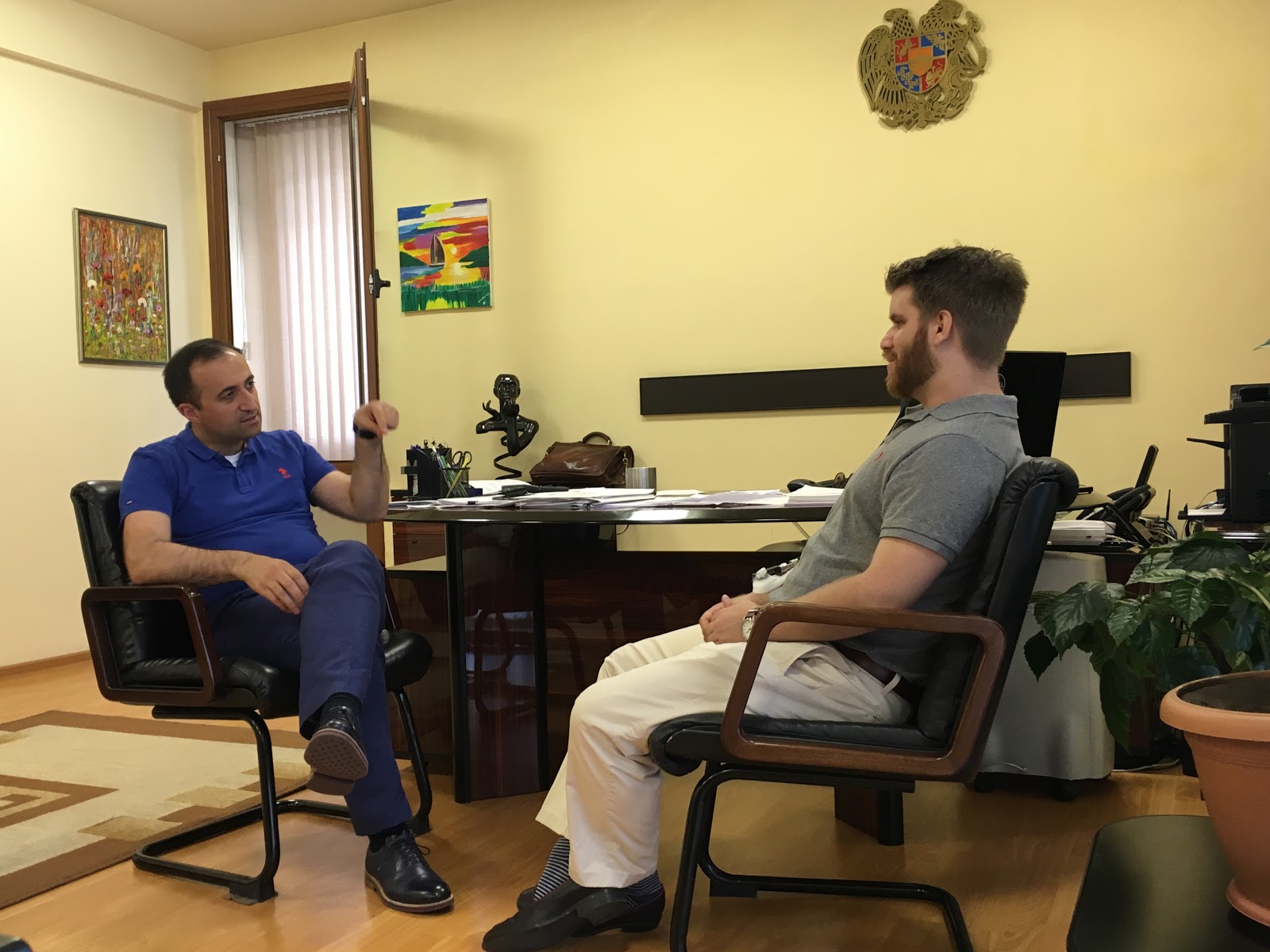
YEREVAN—In an interview with the Armenian Weekly, Armenian Health Minister Arsen Torosyan discussed his Ministry’s priorities in the Pashinyan government’s first term. While praising his predecessor’s successes in reforming primary care, maternity and child care as well as international cooperation, the Minister says there is still much to be done.
The Health Ministry faces three important tasks: promoting preventive treatment, establishing an effective cancer control mechanism and providing universal health coverage.
Studies show that conditions like cardiovascular disease, lung disease, diabetes and cancer are responsible for 80 percent of unnatural deaths among Armenians. The Minister blames the spread of preventable or treatable illnesses on a lack of public outreach coupled with wholly inadequate early detection mechanisms.
In an attempt to reverse this legacy of neglect, the Ministry has adopted a proactive approach to public health management. The plan calls for providing accurate and accessible health information to the general public in tandem with prevention-focused public awareness drives.
When it comes to cancer treatment, Armenia is facing an uphill battle. According to data released by the World Health Organization, Armenia has one of the highest cancer mortality rates in the world with 230 deaths for every 100,000 people. Building on international experience, the Ministry is in the process of replacing its obsolete methodology with a comprehensive cancer control cycle. This revamped structure would emphasize prevention, early detection, effective treatment, patient management and palliative care.
Torosyan revealed to the Armenian Weekly that he is aware that the success of these reforms depends on the resilience of the medical system. The standard of care varies dramatically for medical facilities across the country. The Ministry has already embarked on an ambitious program to overhaul the country’s healthcare management infrastructure.
“Maintaining a countrywide standard for care will be difficult,” explained Torosyan, citing the uneven distribution of resources across hospitals. “However, we have already achieved standardization of primary care.” The Ministry hopes to speed up the process by requiring medical professionals to undergo retraining in line with newly established guidelines. These guidelines are already part of the curriculum for medical students.
Working closely with the global tech giant Ericsson, the government started rolling out a digital patient management tool christened Integrated Health Information System of Armenia (IHISA). At this stage, clinics and hospitals across Armenia have access to standardized billing data. Integrating the entirety of patient clinical data will take longer. This cutting edge e-health platform is expected to cut administrative red tape while preventing incidences of medical malpractice. Previously, misdiagnosis due to incomplete or missing patient records was common with sometimes tragic consequences.
Achieving universal health coverage will be Torosyan’s biggest challenge. The Minister explains “The goal is to set up mechanisms which would help our citizens avoid catastrophic health costs.” According to Torosyan, public and private insurance covers less than 20 percent of treatment costs. The rest is out of pocket. “This is a devastating statistic,” he exclaimed.
The prospect of implementing universal health coverage has been a matter of considerable public debate in Armenian circles. The source of funding remains a major concern for skeptics. The Minister claims that his plan could cover at least 1.6 million beneficiaries in its first stage without massive state subsidies. Armenian workers would be required to contribute to a specific healthcare fund. Torosyan points to similar systems in Estonia and South Korea as evidence of the practicality of his proposal.
The Minister also weighed in on another public debate surrounding the matter. He insists that such a fund should remain public rather than be entrusted to the care of a private management firm. He cites high administrative fees and possible gaps in coverage for vulnerable beneficiaries as reasons to forgo the private option.
However, since this interview first aired on May 24, representatives from international asset management firms have disputed the Minister’s assertions to the Armenian Weekly. In any case, Torosyan had to revise his initial hopes for a 2021 rollout, now deemed too optimistic. Despite continued public debates and budget cuts, he hopes to provide a clear timeline in the coming months.
Torosyan has perhaps been most vocal in his opposition to public smoking. As previously reported by the Armenian Weekly, a bill to ban smoking in public spaces is already making its way through Parliament. This latest draft legislation addresses concerns over unclear wording following the rejection of the previous iteration. The new bill incorporates coherent restrictions on taxation, marketing, sales and public consumption coupled with a targeted anti-smoking campaign. The Minister is confident that the modified measure will pass. “We are pushing it through. There is no way to call it back,” he said. If passed during the National Assembly’s fall session, the law would come into force in the first half of 2020. However, there are signs that it might come much sooner.
Even if the bill becomes law, whether it will be implemented remains to be seen. Armenians are among the most notorious smokers in the world, with some data suggesting smoking rates as high as 60 percent. While previous governments have pushed through some anti-smoking legislation, in practice, they are rarely – if ever – enforced.

As if to illustrate this point, a viral video depicting an altercation on a city bus caused quite a stir on social media this week. The footage shows the bus driver, cheered on by other passengers, barking at a commuter to “mind [her] own business” after she had insisted that he put out his cigarette. Smoking in public transit is considered a criminal misdemeanor according to a 2007 law.
Torosyan admits that enforcement will be the biggest challenge. The Health Ministry is joining forces with the police department to train health and safety inspectors for this purpose. “It will take a lot of time and effort, but we have no other option. We must save our children.”


The WHO data/charts you posted in this article do not necessarily explain why cancer is so prevalent in Armenia. I am wondering if you know of any serious study explaining why.
Keep going sir I am most impressed with what you have already achieved and wish you every success especially in the area of smoking …the scourge of Armenia
First questions that cross my mind are :
-How much will it cost yearly?
-How much the gvt intend to get from the workers, considering that most of them are poor, and the majority very cloose to poverty line.
If those evident questions were not asked to the minister because he was probably unable to answer them, then this is just another PR ops from a government that is very consistent in delivering empty promises, never corroborated by figures or action plan.
Estonia and South Korea, compared to Armenia, have high salaries, low unemployment rate and a higher number of workers vs non workers. Whatever worked there may not be applicable in Armenia.
As the article (and accompanying video interview) points out: there are no definite answers to those questions yet because this is only an idea in its infancy at the moment. The minister says that it will take at least another year to come up with a comprehensive plan.
In the interview, the minister does say that the poorest segments of society will likely continue to have state sponsored healthcare and won’t need to contribute to the fund.
The Estonian average salary is only about 90% higher than Armenia’s, while they have a similar worker – to – non worker ratio. Somehow they’ve figured it out.
Hope that helps!
If its only an idea in its infancy, then lets agree that the title of this article is at best misleading and this will not come any time soon, specially if they still have to figure out how, without shrinking the state budget of course.
The employment to population ratio in Estonia is much higher, 61% vs 48%. Its a big difference when it comes to demography and statistical base.
If the salaries are “only about 90% higher”, lets reduce yours by “only” 90%. Annual nominal wages average abt 16k USD in Estonia while barely making 4k in Armenia… Not mentionning that EU contribute to 800m usd per year to their state budget.
Considering that the minister, in charge for a year now, is unable to estimate even roughly the cost of such measure, it is consistent with what we have seen so far: a government very prompt to make fancy announcements, but regularly failing to explain how they will make it.